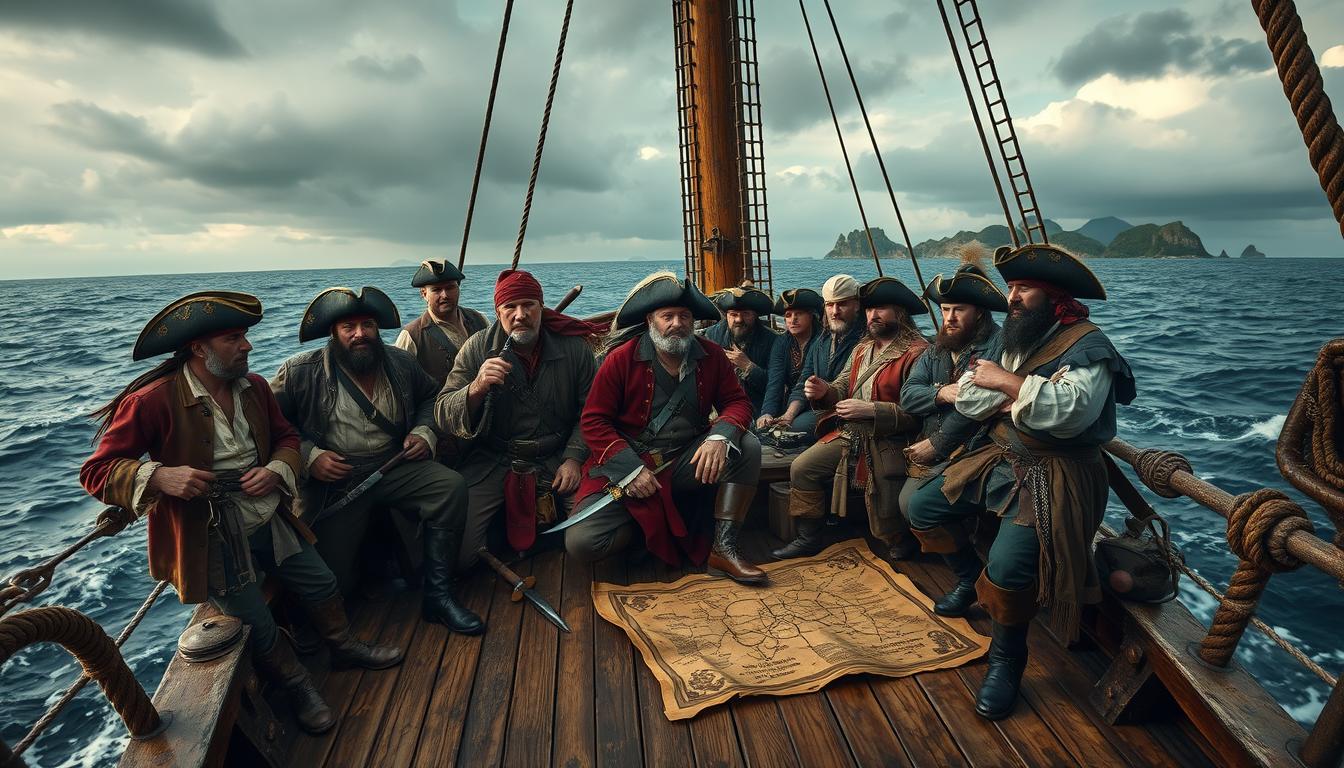Imagine a dimly lit tavern in Nassau in the early 18th century. Sailors gather around a weathered table, swapping stories of sea adventures. These tales mix truth with legend, showing the real world of piracy is more complex than movies make it out to be.
Pirates are more than just eye patches and wooden legs. They are part of a long history of maritime robbery. From 1650 to 1730, about 1,500 pirates roamed the seas, challenging our common beliefs.
Unlike what movies show, pirates were not just mindless thugs. They were skilled individuals who navigated complex social and economic worlds. For example, Blackbeard led around 300 men at his peak, showing great organizational skills.
Key Takeaways
- Piracy is a historical practice of maritime robbery
- Only 1,500 pirates were active during the Golden Age
- Pirates had structured social systems
- Most pirate myths are Hollywood inventions
- Pirate crews were often multiethnic and democratic
Pirate Mythology’s Hollywood Origins
The image of pirates we see today is far from real. Famous pirates have been changed by writers and filmmakers. They’ve created myths that grab people’s attention all over the world. Back in the Golden Age of Piracy, from 1655 to 1725, real pirates looked nothing like the ones in movies.
Writers like Daniel Defoe and Robert Louis Stevenson started shaping the pirate story long before movies. Their stories set the stage for what we see in films today. The “Pirates of the Caribbean” movies made these myths even bigger, turning pirates into legendary figures.
“The most entertaining pirates exist in our imagination, not in historical records.” – Maritime Historian
Hollywood often shows pirates as white European men, ignoring the real variety of pirates. Pirate movies have made a lot of money, over $4.5 billion, showing how much people love these stories. But these films make piracy seem glamorous and far from the harsh truth.
Pirates were not the heroes of movies but people trying to survive and make a living. The myths around them have turned them into exciting figures, far from their real lives.
The Real Pirate Code of Conduct
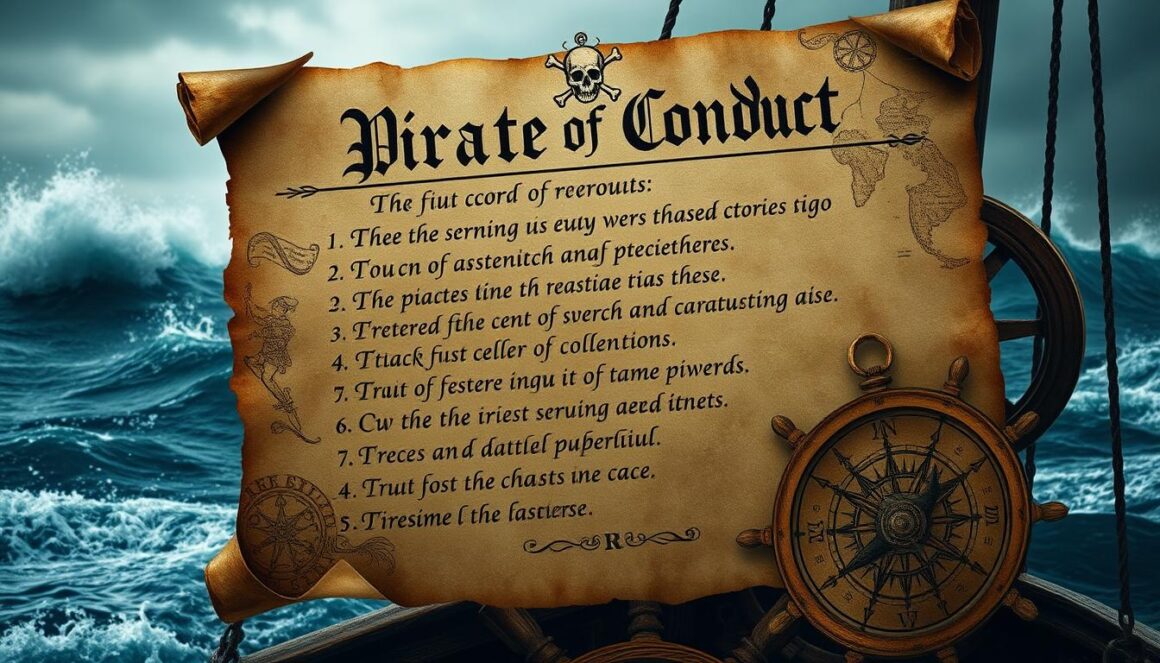
Pirate life was not chaotic at all. In fact, pirate culture was surprisingly organized and democratic. They had strict codes that governed shipboard life.
During the Golden Age of Piracy, crews made detailed agreements called “articles.” Every member had to sign these contracts. They outlined rules for behavior, punishments, and how to solve conflicts. Sadly, only about 0.05% of these codes have survived today.
“No man shall strike another while the articles are in force” – A typical pirate code rule
The codes were very fair. Crew members got to vote on important decisions, with each vote counting equally. Punishments were harsh but fair – theft could mean being left on a deserted island or even death. The captain and quartermaster got more treasure, but everyone was treated fairly.
Pirates also had welfare systems that were ahead of their time. If a crew member got hurt, they got $800 from the ship’s funds. This showed pirates understood the importance of looking out for each other.
These codes were more than just rules. They helped turn groups into disciplined, efficient maritime communities.
Truth About Pirate’s Fashion Choices
Pirates didn’t wear the fancy costumes we see in movies. In real life, they chose clothes for practicality over style. Famous pirates looked more like regular sailors than the flashy characters in films.
Maritime adventurers wore clothes that were useful, not just stylish. They had loose, comfy clothes for moving easily on ships. Their outfits included baggy pants, simple shirts, and strong boots or shoes.
“A pirate’s wardrobe was his survival kit, not a fashion statement.”
The famous eye patch wasn’t just for show. It helped sailors see better in the dark. It protected their eyes when moving from bright to dark areas on a ship.
Most pirates didn’t wear fancy clothes. Their outfits were made from what was available and had to last. Wool, linen, and cotton were common because they were comfortable and durable.
Pirate captains might have worn slightly different clothes. They might use clothes or accessories from their victories to show their status. But, their clothes were always practical first.
Debunking the Buried Treasure Myth
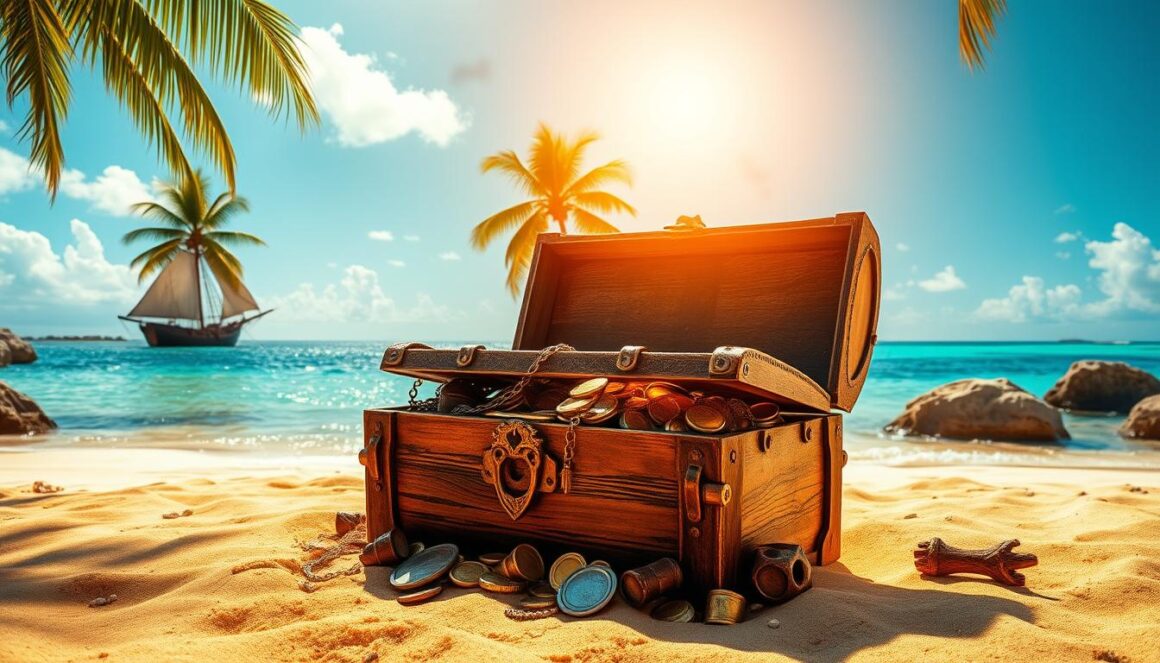
The idea of pirates burying treasure on remote islands is a myth. Caribbean pirates were more focused on survival and making money quickly. They didn’t hide their loot underground.
Pirates quickly turned their stolen goods into things they needed. They traded for food, weapons, and ship parts. The story of buried treasure became popular thanks to “Treasure Island” by Robert Louis Stevenson.
“The golden age of pirates was less about hidden chests and more about daily survival on treacherous seas.”
There are only a few true stories of pirates burying treasure. Captain William Kidd is one example, burying a small amount on Gardiners Island. Most pirates spent their money fast, knowing their lives were short and uncertain.
Today, treasure hunters look for these legends in places like Oak Island and Cocos Island. But after centuries of searching, no big pirate treasure has been found. This shows the myth is just that—a story.
The Reality of Pirate Speech
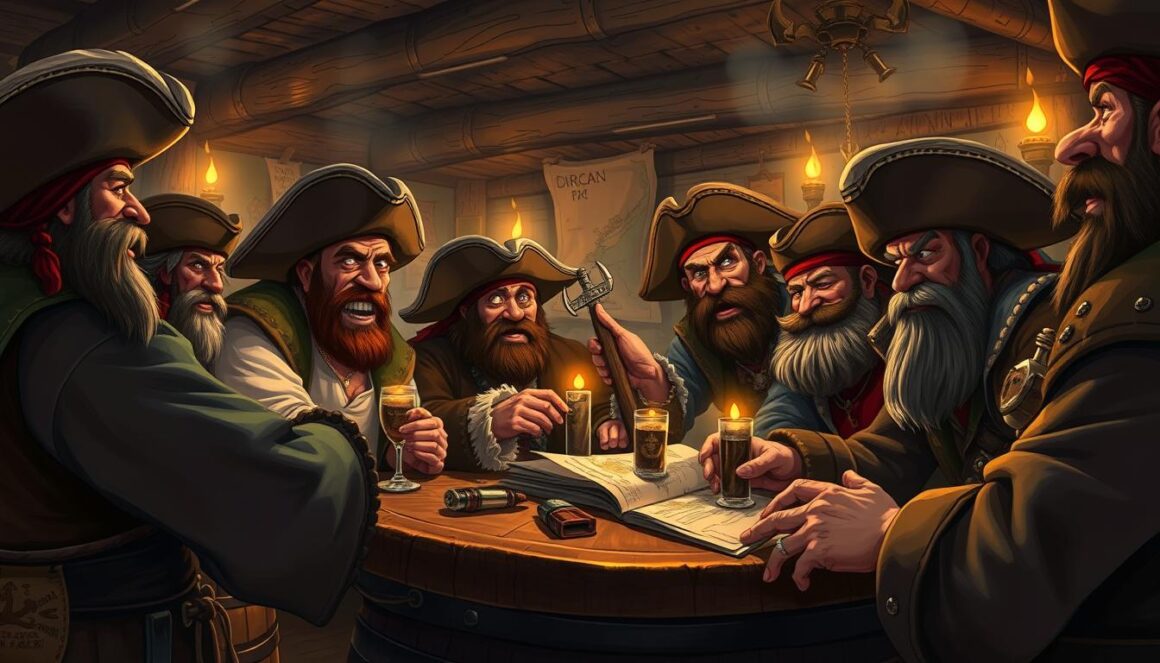
The pirate accent we know today is a Hollywood invention. Robert Newton’s role as Blackbeard in “Treasure Island” (1950) created the iconic pirate speech. His Cornish accent made “Arrr” a symbol of pirate lore.
Pirates in history spoke many languages and dialects. Their crews were diverse, with members from Europe, Africa, and the Caribbean. This diversity meant their speech varied greatly, depending on where they were from.
“The sea speaks many languages, and so did its sailors.” – Maritime Historian
Real pirates used nautical terms, not the “pirate myths” of movies. They spoke about navigation, ship upkeep, and crew life using practical words. The idea of pirate speech we see in films is mostly made-up.
International Talk Like a Pirate Day, started in 1995, has made these myths more popular. It began as a joke but has stuck, giving us a wrong view of pirate talk from the Golden Age.
Pirates and Their Supposed Parrots
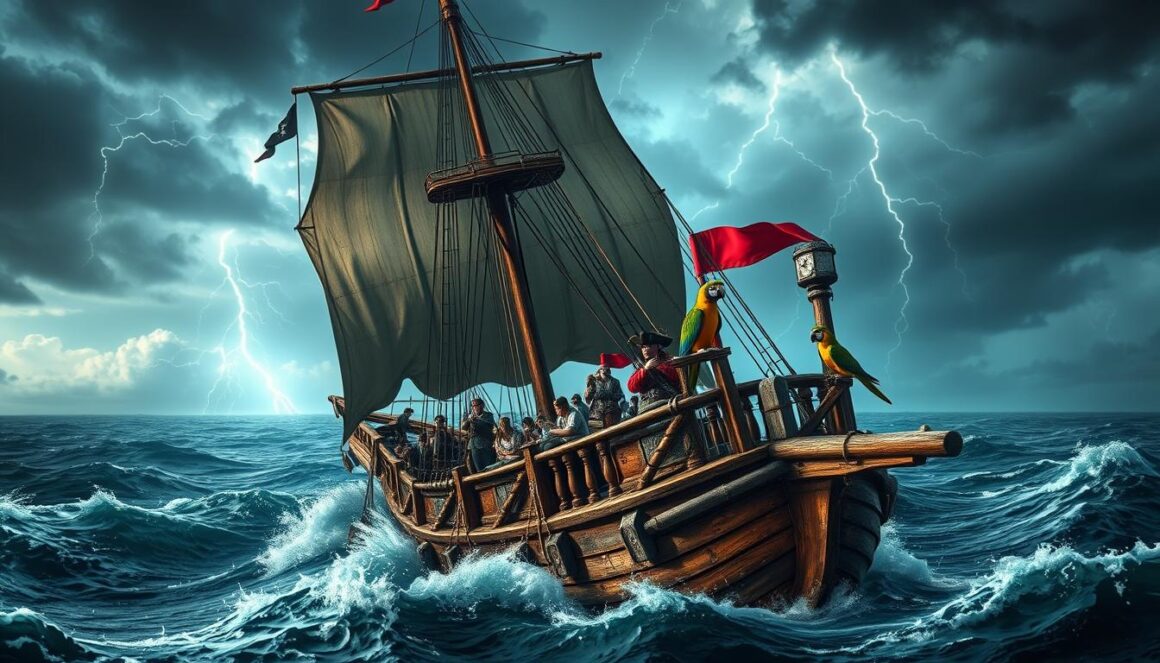
The idea of pirates with parrots is a popular myth in our culture. Pictures of pirates with colorful birds on their shoulders are everywhere. But, history shows this wasn’t common among real pirates.
Pirate life was more about survival than fancy pets. Sailors might bring back exotic animals, but parrots were not a usual sight. This image likely came from stories like Robert Louis Stevenson’s “Treasure Island”, which made pirate life seem more glamorous.
“The parrot became a symbol of exotic adventure, not a common companion for real pirates.”
Parrots were valuable in royal courts because they could talk. They were first seen in ancient Greece around 386 BC. For pirates, a parrot was more of a trade item than a pet.
Historians say pirates focused on survival, not pets. Their life was tough, with little room for pets. Ships were crowded, and resources were scarce. A parrot would have been a burden during battles or long trips.
Even though the pirate and parrot myth is captivating, it’s not based on real pirate life.
Fact-Checking Pirate Ships and Battles
Pirate ships were not as big as movies make them out to be. Caribbean pirates liked fast schooners and sloops. These ships were great for quick attacks and fast escapes in shallow waters.
“Speed was a pirate’s greatest weapon, not size” – Maritime Historian
Pirate ships were not huge like the galleons in movies. Most pirates sailed single-masted ships for speed and agility. They aimed to scare, not fight long battles. Just showing a scary flag could make merchant ships give up without a fight.
Boarding was a last choice for pirates. They knew fighting was risky. They used smart tactics and quick escapes instead of brute force. Their small ships could sneak up, scare, and then leave fast.
Pirate battles were not as exciting as movies show. Pirates focused on making money, not on big battles. Their ships were for making money, not for adventure.
Conclusion: The Truth About Pirates: Separating Fact from Hollywood Myths
The truth about pirates is much more complex than what Hollywood shows. In the Golden Age of Piracy, pirates were not just heroes. They were smart people trying to survive and make money.
Pirates came from poor backgrounds and wanted better lives. Some pirate ships were like democracies, where everyone had a say. They didn’t just look for treasure; they fought for survival and a chance to make money.
It’s time to move past the myths of pirates. They didn’t wear eye patches or have parrots, and they didn’t just bury treasure. Pirates were rebels who challenged the status quo and found freedom in tough times.
Looking into the truth about pirates teaches us a lot. It shows us how people acted, made money, and lived together in the 17th and 18th centuries. By clearing up myths, we get a deeper understanding of these fascinating communities.
FAQ
Were pirates really as lawless and brutal as movies portray them?
Pirates were not as wild as movies make them out to be. Many pirate crews were organized and had rules. They elected their captains and divided loot fairly. Pirates were smart and practical, not just bloodthirsty.
Did pirates actually bury their treasure?
Treasure burial is a myth. Pirates usually sold their loot for food and supplies. Sometimes, they hid treasure, but it was rare. Pirates focused on survival, not making treasure maps.
What kind of ships did real pirates use?
Pirates sailed small, fast ships like sloops and schooners. These ships were better for quick escapes and navigating shallow waters. Speed was key for pirates.
Did pirates really talk like they do in movies?
The pirate accent is a movie creation, thanks to Robert Newton’s Blackbeard in 1950. Real pirates spoke in many ways, depending on where they were from.
Were eye patches and parrots really common among pirates?
Eye patches and parrots are myths. Pirates might have used eye patches for injuries. But parrots on every pirate ship are just a story.
How did pirates organize their crews?
Pirates had democratic systems. They elected captains and followed rules for sharing loot and solving problems. It was a fair system.
What did pirates actually wear?
Pirates wore sailor’s clothes, not fancy costumes. Their clothes were practical, not for show.
Were pirates from a specific region?
Pirates sailed all over, but the Caribbean was famous. They came from many places, showing the diversity of the sea.
How did pirates choose their targets?
Pirates were smart, preferring to scare ships into giving up. They used flags and force to get what they wanted without fighting.
Were all pirates criminals?
Not all were pirates. Privateers were pirates with government permission to attack during war. They were not all criminals.

